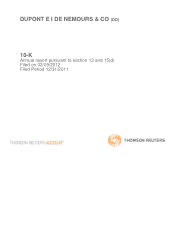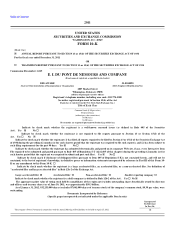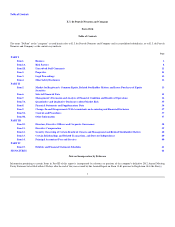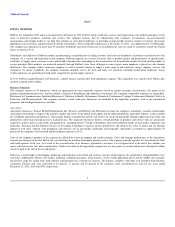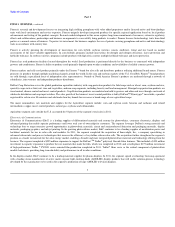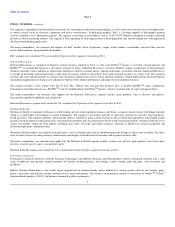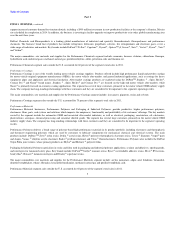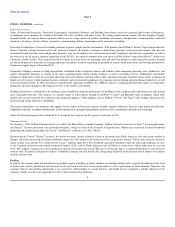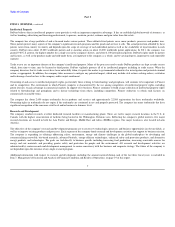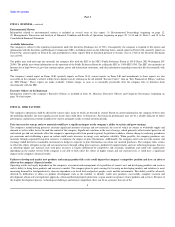DuPont 2011 Annual Report Download - page 5
Download and view the complete annual report
Please find page 5 of the 2011 DuPont annual report below. You can navigate through the pages in the report by either clicking on the pages listed below, or by using the keyword search tool below to find specific information within the annual report.
Table of Contents
Part I
ITEM 1. BUSINESS
DuPont was founded in 1802 and was incorporated in Delaware in 1915. DuPont brings world-class science and engineering to the global marketplace in the
form of innovative products, materials and services. The company believes that by collaborating with customers, governments, non-governmental
organizations and thought leaders it can help find solutions to such global challenges as providing enough healthy food for people everywhere, decreasing
dependence on fossil fuels, and protecting life and the environment. Total worldwide employment at December 31, 2011 , was approximately 70,000 people.
The company has operations in more than 90 countries worldwide and about 65 percent of consolidated net sales are made to customers outside the United
States of America (U.S.).
Subsidiaries and affiliates of DuPont conduct manufacturing, seed production or selling activities and some are distributors of products manufactured by the
company. As a science and technology based company, DuPont competes on a variety of factors such as product quality and performance or specifications,
continuity of supply, price, customer service and breadth of product line, depending on the characteristics of the particular market involved and the product or
service provided. Most products are marketed primarily through DuPont's sales force, although in some regions, more emphasis is placed on sales through
distributors. The company utilizes numerous suppliers as well as internal sources to supply a wide range of raw materials, energy, supplies, services and
equipment. To ensure availability, the company maintains multiple sources for fuels and many raw materials, including hydrocarbon feedstocks. Large
volume purchases are generally procured under competitively priced supply contracts.
In 2011, DuPont acquired Danisco A/S (Danisco), a global enzyme and specialty food ingredients company. This acquisition was valued at $6.4 billion, plus
net debt assumed of $0.6 billion.
Business Segments
The company consists of 14 businesses which are aggregated into nine reportable segments based on similar economic characteristics, the nature of the
products and production processes, end-use markets, channels of distribution and regulatory environment. The company's reportable segments are Agriculture,
Electronics & Communications, Industrial Biosciences, Nutrition & Health, Performance Chemicals, Performance Coatings, Performance Materials, Safety &
Protection and Pharmaceuticals. The company includes certain embryonic businesses not included in the reportable segments, such as pre-commercial
programs, and nonaligned businesses in Other.
Agriculture
Agriculture businesses, Pioneer Hi-Bred International, Inc. (Pioneer) and DuPont Crop Protection, leverage the company's technology, customer relationships
and industry knowledge to improve the quantity, quality and safety of the global food supply and the global production agriculture industry. Land available
for worldwide agricultural production is increasingly limited so production growth will need to be achieved principally through improving crop yields and
productivity rather than through increases in planted area. The segment's businesses deliver a broad portfolio of products and services that are specifically
targeted to achieve gains in crop yields and productivity, including Pioneer® brand seed products and well-established brands of insecticides, fungicides and
herbicides. Research and development focuses on leveraging technology to increase grower productivity and enhance the value of grains and soy through
improved seed traits, superior seed germplasm and effective use of insecticides, herbicides and fungicides. Agriculture accounted for approximately 50
percent of the company's total research and development expense in 2011.
Sales of the company's products in the segment are affected by seasonal cropping and weather patterns. Sales and earnings performance in the Agriculture
segment are strongest in the first half of the year reflecting the northern hemisphere planting season. The segment generally operates at a loss during the third
and fourth quarters of the year. As a result of the seasonal nature of its business, Agriculture's inventory is at its highest level at the end of the calendar year
and is sold down in the first and second quarters. Trade receivables in the Agriculture segment are at a low point at year-end and increase through the selling
season to peak at the end of the second quarter.
Pioneer is a world leader in developing, producing and marketing corn hybrid and soybean varieties which improve the productivity and profitability of its
customers. Additionally, Pioneer sells canola, sunflower, sorghum, inoculants, wheat and rice. As the world's population grows and the middle class expands,
the need for crops for animal feed, food, biofuels and industrial uses continues to increase. The business competes with other seed and plant biotechnology
companies. Pioneer seed sales amounted to 16 percent, 17 percent and 18 percent of the company's total consolidated net sales for the years ended
December 31, 2011, 2010 and 2009, respectively.
2

